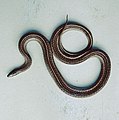Fox's mountain meadow snake
| Fox's mountain meadow snake | |
|---|---|
| Scientific classification | |
| Domain: | Eukaryota |
| Kingdom: | Animalia |
| Phylum: | Chordata |
| Class: | Reptilia |
| Order: | Squamata |
| Suborder: | Serpentes |
| Family: | Colubridae |
| Genus: | Thamnophis |
| Species: | T. foxi |
| Binomial name | |
| Thamnophis foxi | |
 | |
| Synonyms[2] | |
Fox's mountain meadow snake (Thamnophis foxi), also known commonly as culebra-de vega de Fox and pradera de Fox in Mexican Spanish, is a species of viviparous snake in the family Colubridae. The species, which was described by Douglas A. Rossman and Richard M. Blaney in 1968, is native to northwestern Mexico.[1][2]
Etymology[edit]
The specific name, foxi, is in honor of American herpetologist Wade Fox Jr. (1920–1964).[3]
Geographic range[edit]
T. foxi is found in the Mexican state of Durango.[1][2]
Habitat[edit]
The preferred natural habitat of T. foxi is forest, at an altitude of 2,600 m (8,500 ft).[1]
Description[edit]
The holotype of T. foxi has a total length (including tail) of 42 cm (17 in). It has five upper labials. The dorsal scales are in 17 rows throughout the length of the body. The anal scale is entire (undivided).[2]
Pictures[edit]
Reproduction[edit]
The mode of reproduction of T. foxi is uncertain. The IUCN describes the species as ovoviviparous,[1] whereas the Reptile Database describes it as oviparous.[2]
Conservation status[edit]
Specimens LSU40793 and LSU40846 were the last recorded specimens of T. foxi, consisting of a male and female collected on 18 and 19 July 1981 in southwestern Durango, Mexico, most likely around 1.5 miles (2.4 km) west of El Salto. While no detailed location information is included in the specimen record, it is noted that the same collector visited this location almost yearly in the late 1960s.[citation needed]
Threats to the survival of this snake species include ongoing deforestation caused by logging.[1] The area contains pine and pine-oak forests of Pinus durangensis that have been heavily logged and are now severely disturbed. Parts of the area are being reforested for forestry purposes, but it is not known whether reforested P. durangensis stands are suitable for this snake species.[1]
References[edit]
- ^ a b c d e f g Mendoza-Quijano, F.; Santos-Barrera, G. (2007). "Adelophis foxi ". IUCN Red List of Threatened Species. 2007: e.T63728A12711297. doi:10.2305/IUCN.UK.2007.RLTS.T63728A12711297.en. Retrieved 19 November 2021.
- ^ a b c d e Thamnophis foxi at the Reptarium.cz Reptile Database. Accessed 7 July 2017.
- ^ Beolens, Bo; Watkins, Michael; Grayson, Michael (2011). The Eponym Dictionary of Reptiles. Baltimore: Johns Hopkins University Press. xiii + 296 pp. ISBN 978-1-4214-0135-5. (Adelophis foxi, p. 93).
Further reading[edit]
- Hallas JM, Parchman TL, Feldman CR (2021). "Phylogenomic analyses resolve relationships among garter snakes (Thamnophis: Natricinae: Colubridae) and elucidate biogeographic history and morphological evolution". Molecular Phylogenetics and Evolution 167: 107374. (Thamnophis foxi, new combination).
- Heimes P (2016). Snakes of Mexico: Herpetofauna Mexicana Vol. I. Frankfurt am Main, Germany: Chimaira. 572 pp. ISBN 978-3899731002.
- Rossman DA, Blaney RM (1968). "A new Natricine snake of the genus Adelophis from western Mexico". Occasional Papers of the Museum of Zoology, Louisiana State University 35: 1–12. (Adelophis foxi, new species).
- Rossman D, Wallach V (1987). "Adelophis Dugès, Mountain Meadow Snakes". Catalogue of American Amphibians and Reptiles 408: 1–2.


 French
French Deutsch
Deutsch

